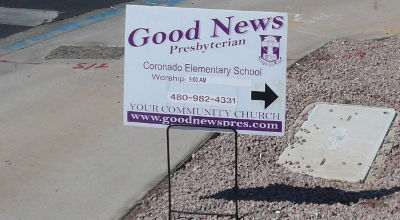Church Battles Double-Standard Sign Regulations
Alliance Defending Freedom attorneys have asked the full U.S. Court of Appeals for the 9th Circuit to weigh in on a church’s lawsuit over a Phoenix suburb’s flawed sign ordinance. On Feb. 8, a three-judge panel ruled 2-1 against Good News Community Church, whose signs are subjected by the town of Gilbert to greater regulation than similar non-commercial signs.
“A city’s sign ordinances shouldn’t burden churches with restrictions that don’t apply equally to all similar signs,” said Senior Legal Counsel Jeremy Tedesco, who argued before the three-judge panel on behalf of the church in August of last year.
“The government cannot require churches to abide by these stricter rules when it doesn’t place them on ideological, political, and other non-commercial signs that are comparable in nature. The Constitution prohibits that kind of discrimination.”
“Good News Community Church and its Pastor…seek to place signs in Gilbert inviting people to their Church services,” the petition for review filed Friday in Reed v. Town of Gilbert explains. “These temporary signs ‘communicate a religious message’ and are thus entitled to the highest level of constitutional protection. Yet because they contain some directional information, the panel says the Town can severely restrict them, while at the same time granting far more favorable treatment to temporary political, ideological, and other similar signs. This figure illustrates the Town’s unequal treatment of signs.”
In May 2007, in response to the lawsuit, the town agreed to a preliminary injunction prohibiting it from enforcing its sign code against the church. The town then passed an amended code, but the revision continued to discriminate against the church’s signs, so litigation continued.
Under the town’s code, political signs in Gilbert can be up to 32 square feet, placed in public rights-of-way, and displayed for many weeks. An ideological sign can be up to 20 square feet, placed in public rights-of-way, and displayed indefinitely. The church’s signs can only be 6 square feet, cannot be placed in public rights-of-way, and may not be displayed more than 12 hours before or one hour after a worship service or other church event.
In a dissent accompanying the 9th Circuit panel’s ruling earlier this month, Circuit Judge Paul Watford commented on the discrepancies: “Gilbert has merely offered, as support for the sign ordinance as a whole, its interest in enhancing traffic safety and aesthetics. …. But to sustain the distinctions it has drawn, Gilbert must explain why (for example) a 20-square-foot sign displayed indefinitely at a particular location poses an acceptable threat to traffic safety and aesthetics if it bears an ideological message, but would pose an unacceptable threat if the sign’s message instead invited people to attend Sunday church services. Gilbert has not offered any such explanation, and I doubt it could come up with one if it tried.”
“What we are left with, then,” the dissent continued, “is Gilbert’s apparent determination that ‘ideological’ and ‘political’ speech is categorically more valuable, and therefore entitled to greater protection from regulation, than speech promoting events sponsored by non-profit organizations. That is precisely the value judgment that the First and Fourteenth Amendments forbid Gilbert to make.”













